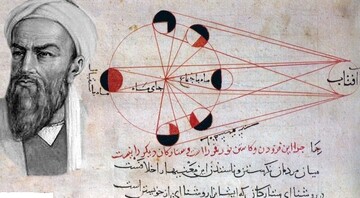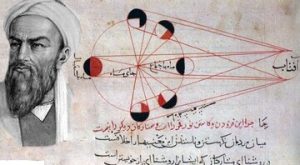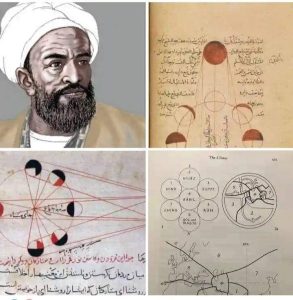Abu Reyhan Biruni (973–1048), one of the greatest Iranian polymaths, made groundbreaking discoveries in astronomy, geography, and physics that were centuries ahead of their time. 600 years before Galileo, he had already determined that Earth was a sphere. Even more astonishingly, 500 years before Copernicus, Biruni had explored the concept that Earth orbits the Sun.
He also depicted the different phases of the Moon relative to the Sun in his book Kitab al-Tafhim li Awa’il Sina‘at al-Tanjim, proving his deep understanding of celestial mechanics.
Yet, Western narratives have largely ignored his contributions, instead crediting later European astronomers like Copernicus and Galileo for ideas Biruni had already conceptualized centuries earlier. This article explores Biruni’s extraordinary scientific achievements and why they deserve global recognition.
Who Was Abu Reyhan Biruni? The Iranian Polymath Who Changed Science Forever
Born in Khwarazm (modern-day Uzbekistan, then part of Greater Iran), Abu Reyhan Biruni was a scientist, historian, mathematician, and astronomer. His vast knowledge encompassed physics, geography, medicine, and comparative religion.
Unlike many medieval scholars, Biruni relied on empirical observations and mathematical calculations, setting a scientific standard that prefigured the Renaissance method by centuries.
With over 146 books covering multiple disciplines, he was among the most prolific scientists of the Islamic Golden Age.
File:Lunar phases al-Biruni, source: https://en.m.wikipedia.org/wiki/File:Lunar_phases_al-Biruni.jpg
Biruni’s Revolutionary Contributions to Science
1. Biruni Knew Earth Was a Sphere 600 Years Before Galileo
Biruni’s precise calculation of Earth’s radius and circumference was one of his most astonishing achievements.
- He used an advanced trigonometric method to measure the Earth’s curvature from a mountain’s peak.
- His calculations yielded a value for Earth’s radius that was remarkably close to modern measurements.
- Unlike many medieval scholars who relied on religious texts, Biruni used pure scientific reasoning to determine that Earth is round.
This discovery predated Galileo (1564–1642) by more than six centuries, yet Galileo is commonly credited as the scientist who proved Earth’s sphericity.
👉 Read more about Biruni’s Earth measurement: Wikipedia: Al-Biruni’s Earth Radius Calculation
2. Biruni Proposed Heliocentrism 500 Years Before Copernicus
Today, Nicolaus Copernicus (1473–1543) is widely credited with introducing heliocentrism—the idea that Earth orbits the Sun. However, Biruni discussed this concept over 500 years earlier!
- He questioned the geocentric model of Ptolemy, which placed Earth at the center of the universe.
- In his works, he analyzed the possibility that Earth revolved around the Sun, demonstrating a profound understanding of planetary motion.
- While he did not fully adopt heliocentrism, he presented it as a viable scientific hypothesis, centuries before Copernicus.
👉 Explore more about Copernicus and heliocentrism: Wikipedia: Copernican Revolution
3. Biruni’s Astronomy: Understanding the Phases of the Moon
In his book Kitab al-Tafhim, Biruni depicted the different phases of the Moon relative to the Sun.
- He meticulously explained how the Moon’s illumination changes based on its position relative to Earth and the Sun.
- His diagrams closely resemble modern lunar phase charts, demonstrating his advanced observational skills.
This discovery preceded many later European astronomical models, proving that Persian scientists were far ahead of their time.
👉 Read more about lunar phases: Wikipedia: Lunar Phases
Why Has Biruni Been Ignored in Western Science?
Despite his revolutionary ideas, Biruni’s contributions have been overshadowed in mainstream Western historical accounts.
-
Limited Transmission of Knowledge to Europe
- Some of his works were translated into Latin, but many of his most advanced theories remained unknown to European scholars.
- Later European astronomers like Copernicus, Kepler, and Galileo built upon Islamic scientific advancements without citing their sources.
-
Eurocentric Historiography
- Western history books often credit European scientists for ideas that originated in the Islamic world.
- The Islamic Golden Age, which produced scholars like Biruni, Nasir al-Din al-Tusi, and Al-Khwarizmi, has been largely erased from mainstream narratives.
-
The Copernican Revolution Without Islamic Acknowledgment
- Copernicus borrowed from Islamic astronomy, yet he never credited figures like Biruni or Tusi.
- The scientific community continues to celebrate European astronomers while ignoring their Persian and Arab predecessors.
Conclusion: Recognizing Iran’s True Role in Scientific History
600 years before Galileo, Biruni knew Earth was round. 500 years before Copernicus, he proposed heliocentrism. His scientific accuracy and mathematical precision prove that Persian scholars played a foundational role in modern astronomy.
Yet, his contributions remain largely ignored in Western narratives. It is time to rewrite history and acknowledge Abu Reyhan Biruni as a true pioneer of planetary science.
Further Reading:
- Abu Reyhan Biruni – Wikipedia
- Biruni’s Contributions to Astronomy
- The Forgotten Islamic Scientists Who Shaped the Modern World
- The Copernican Revolution
By recognizing figures like Biruni, we take a step toward a more inclusive and accurate representation of scientific history.



